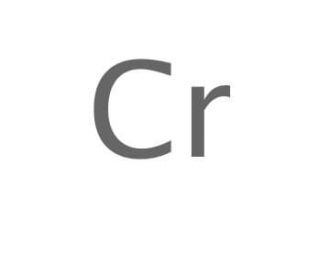

Chromium (CAS 7440-47-3)
QUICK LINKS
Chromium is a trace element that plays a role in glucose metabolism. Chromium, an essential trace element, can be found in various foods, including meats, vegetables, and grains. Its significance lies in being a nutrient for humans, playing a vital role in the metabolism of carbohydrates and fats. Furthermore, chromium is not only present in dietary supplements but is also employed in laboratory experiments to examine its impact on biochemical processes. In scientific research, chromium finds widespread application, particularly in investigating its effects on biochemical processes. Researchers have utilized it to explore the correlation between insulin and glucose metabolism, its role in regulating glucose and lipid metabolism, as well as its ability to modulate immune system function. Moreover, chromium has proven valuable in assessing the influence of environmental pollutants on human health and its potential as an antioxidant. One of the key beliefs surrounding chromium is its role as an insulin sensitizer, which implies that it enhances the body′s sensitivity to insulin. This is achieved by increasing the number of insulin receptors on cells, thereby facilitating a higher uptake of glucose by cells. Additionally, chromium exhibits antioxidant properties that contribute to safeguarding cells against damage caused by free radicals. This comprehensive exploration of chromium sheds light on its importance as a trace element and its manifold implications in scientific research. By better understanding chromium′s functions, researchers can potentially unlock further discoveries that could benefit human health and well-being.
Chromium (CAS 7440-47-3) References
- [Chromium carcinogenicity]. | Trocha, M., et al. 1999. Med Pr. 50: 163-77. PMID: 10472621
- Chromium: friend or foe? | Porter, DJ., et al. 1999. Arch Fam Med. 8: 386-90. PMID: 10500510
- The biochemistry of chromium. | Vincent, JB. 2000. J Nutr. 130: 715-8. PMID: 10736319
- Chromium, exercise, and body composition. | Kobla, HV. and Volpe, SL. 2000. Crit Rev Food Sci Nutr. 40: 291-308. PMID: 10943591
- Chromium as adjunctive treatment for type 2 diabetes. | Ryan, GJ., et al. 2003. Ann Pharmacother. 37: 876-85. PMID: 12773078
- [Chromium and insulin resistance]. | Kleefstra, N., et al. 2004. Ned Tijdschr Geneeskd. 148: 217-20. PMID: 14983576
- Attenuation of chromium toxicity by bioremediation technology. | Mohanty, M. and Patra, HK. 2011. Rev Environ Contam Toxicol. 210: 1-34. PMID: 21170701
- Strategies for chromium bioremediation of tannery effluent. | Garg, SK., et al. 2012. Rev Environ Contam Toxicol. 217: 75-140. PMID: 22350558
- Chromium speciation, bioavailability, uptake, toxicity and detoxification in soil-plant system: A review. | Shahid, M., et al. 2017. Chemosphere. 178: 513-533. PMID: 28347915
- Study on detoxification and removal mechanisms of hexavalent chromium by microorganisms. | Tang, X., et al. 2021. Ecotoxicol Environ Saf. 208: 111699. PMID: 33396030
- Chromium pollution and its bioremediation mechanisms in bacteria: A review. | Pushkar, B., et al. 2021. J Environ Manage. 287: 112279. PMID: 33706095
- Chromium toxicity and its remediation by using endophytic bacteria and nanomaterials: A review. | Murthy, MK., et al. 2022. J Environ Manage. 318: 115620. PMID: 35772275
- Chromium, glucose intolerance and diabetes. | Anderson, RA. 1998. J Am Coll Nutr. 17: 548-55. PMID: 9853533
Ordering Information
| Product Name | Catalog # | UNIT | Price | Qty | FAVORITES | |
Chromium, 5 g | sc-214714 | 5 g | $20.00 | |||
Chromium, 100 g | sc-214714A | 100 g | $39.00 |
